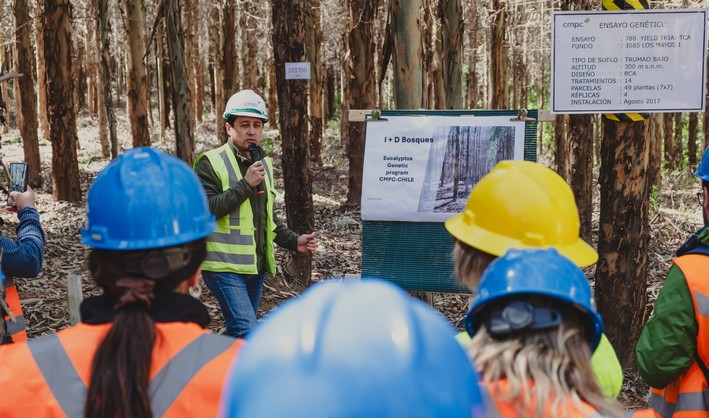The Absent Yet Necessary Afforestation Policy
For the past ten years, afforestation in Chile has been almost nonexistent, in absurd contrast to the commitments made to achieve urgent carbon neutrality and mitigate climate change. The past state policy that allowed the planting of 2.5 million hectares on eroded soils, leading to the formation of one of the country's most important industries, now needs to be revitalized.
In the mid-19th century, Chile faced a severe problem of soil loss due to erosion across nearly 11 million hectares of its territory. At that time, a remarkable state-led effort began to combat this issue, supported by knowledge contributed by individuals from various sectors of society.
From those years until 2012, this strategic effort enabled the country to afforest 2.5 million hectares of productive forests and 800,000 hectares of native forests—now protected and managed by small landowners—forming one of the key productive sectors in the national GDP and the most significant in the southern region.
Mario Hermosilla Daudet, a leader of small and medium-sized forest landowners, reflects: "It was a long-term development story driven by concerned people. From that time until ten years ago, the focus was soil protection—a renewable resource that ends up in rivers and dunes and takes millions of years to form again. Through afforesting these eroded hectares, a sector was developed that generates over $20 million annually and supports more than 2 million people. This effort validated forest species in a lengthy process without improvisation. Afforestation in Chile meant gaining valuable experience, making current afforestation challenges more efficient and less costly. The country already has extensive knowledge; foresters' actions now carry far less risk. Today, Chile has the species, knows their growth rates and suitable locations, and has mastered establishment technology."
A forestry consultant for investment funds and member of the Ministry of Agriculture's Advisory Council highlights the Chilean state's vision in creating necessary tax incentives for an industry that proved highly profitable, contributing significantly to national revenue, as well as state-owned companies that spurred the sector's growth. "It was the Chilean state that had the vision and created pulp companies. The private sector also participated through this state policy, which was tremendously profitable for the treasury—and this is crucial to note—the two major companies, ARAUCO and Mininco, paid over $800 million in taxes. If we sum all state subsidies granted under Decree Law 701, the amount was less than that."
However, the forestry sector isn't just composed of the two large companies; today, there are about 700 others whose fiscal contributions remain unknown. "The treasury should assess how much these smaller companies contribute because investing in forests has been very profitable for Chile. And if it was profitable before, it will be even more so now." Hermosilla refers to his conviction that a new afforestation cycle will occur, involving both private and state actors, listing incentives for this. The main one is forests' role in mitigating climate change. Trees accumulate about 20 tons of CO2 per hectare annually through photosynthesis. 60% of this CO2 is stored in undisturbed soil, while the remaining 40% is stored in trees. "Forests—both native and productive—are crucial carbon sinks, like oceans and peatlands, because wood also stores carbon. This underscores their importance in construction, where producing a ton of cement emits CO2, while wood production captures it. In this sense, wood use is now a global force," adds Hermosilla.
Another strong argument for afforestation is that forests can capture 5 to 8.5 times more water than barren or sparsely vegetated soils. "Remember, forests intercept rain, prevent runoff, and allow water to recharge groundwater—something that doesn’t happen in treeless areas. Society hasn’t emphasized this, but people are starting to hear and discuss this role," he explains.
Afforestation Commitments
For Eduardo Morales Verdugo, a Forestry Engineer from the University of Chile and Master of Science in Natural Resource Planning and Conservation from the University of Michigan, Chile's forestry past was exemplary: "There were periods when plantations expanded first, followed by industry. By my estimates, around 360,000 hectares were established when CORFO launched its Horcones pulp plant, followed by Constitución, while Laja was already operational. Everything afterward was a net addition to Chile's natural capital."
Mario Hermosilla adds that Chile stalled halfway in afforestation. "We afforested 2.5 million hectares, with 2 million left—500,000 in the north and 1.5 million from Santiago southward. Proven species play a key role here: Tamarugo and Algarrobo in the north, and forage shrubs like Atriplex. From Santiago south, radiata pine—the backbone of Chile's sawmill industry—thrives in the sixth, seventh, and northern eighth regions, where native forests or other introduced species aren’t viable." He explains that native forests grow at 2-3 m³ per hectare annually, while pine grows 18-25 m³/ha/year. "Pine matures in 20-24 years, native forests in about 100 years, yielding only firewood in the end."
Morales criticizes Chile's afforestation commitments toward carbon neutrality. "With Chile committed to NDCs, it’s baffling that 200,000 hectares remain unafforested and no action is taken, especially seven years from the Paris Agreement deadline. Ideology plays a role; greater openness is needed to understand these species' impact. If native species are preferred, fine—but honor the 200,000-hectare commitment with fast-growing, efficient carbon-capturing species. A little generosity is needed; we all have green hearts."
Both agree authorities lack a national vision for afforestation and its benefits. "That’s why it’s essential to account for taxes paid by forestry entrepreneurs and the industry. Since 2012, when incentive decrees ended, governments haven’t developed a vision. Unfortunately, the 701 Decree was politicized. We must discuss this broadly because global trends matter," Hermosilla stresses.
Global Demand for Wood
At Expocorma 2022, Agriculture Minister Esteban Valenzuela pledged to advance a new wood promotion law in 2023, emphasizing support for small and medium owners to improve native forest management and regional impact. "A new forest cycle is coming—green wood, social inclusion, and added value." This aligns with soaring global demand and rising radiata pine prices, now highly profitable.
Hermosilla projects forestry’s growth over 50 years but disagrees with the minister’s native forest focus. "For viability, it must be profitable. Chilean native species aren’t profitable anywhere. Look back—name one native-forest venture still profitable and unbankrupted." He adds, "Native forests require heavy investment and undeveloped know-how. The forestry sector developed this for pine and eucalyptus—genetics, silviculture, harvest. A whole industry thrives on these species, meeting domestic and global demand. Government efforts with native species cost 20 times more, require intensive care, and rarely succeed."
"Globally, there’s a massive pro-wood, pro-construction, pro-CO2-storage movement. In Chile, 60% of future carbon storage relies on forests. CO2 trading will merge with wood sales—it’s already happening. Environmental profitability will mirror the U.S., where investment funds profit from carbon credits," Hermosilla explains.
Eduardo Morales, former dean at Universidad Austral, advocates subsidies for small and medium landowners to address wood shortages and degraded soils. "Chile has exceptional forestry culture—wood applications, genetics, silviculture, agroforestry. This knowledge wouldn’t exist without afforestation policies."
Juan Anzieta, Environmental Manager, Forestal Arauco
NDCs explicitly commit to afforesting 200,000 hectares this decade, but progress in 2020-2022 has been minimal.
Afforestation is crucial for Chile’s 2050 carbon neutrality goal. With greater ambition, the forestry sector could accelerate this timeline.
These commitments also ensure the sector’s economic, social, and environmental sustainability. For instance, timber SMEs face structural wood shortages, solvable only through sustained afforestation—key for southern employment.
Environmentally, degraded soils still need restoration to provide ecosystem services like supply, regulation, and support.
Modern afforestation must integrate landscape concepts. Arauco’s "Productive Protected Landscapes" model balances wood production with ecosystem services (water, carbon, wild fruits) while safeguarding environmental values. This requires mixed-use planning.
Learning from global successes, incentives—state-backed or market-driven (e.g., carbon credits)—are needed.
Cross-sectoral agreements are vital for landscape restoration, with afforestation as a cornerstone. Tailored approaches are needed across southern Chile’s diverse conditions, leveraging shared public-private knowledge.
Nicolás Gordon, Corporate Sustainability Manager, CMPC
Future forestry policy must prioritize sustainable forest management. CMPC recognizes the need for evolution—not overhaul—balancing progress with dependency on natural elements.
Our reliance on nature makes its protection and care imperative. Past focus was lacking, but now nearly all CMPC holdings are FSC-certified, meeting global standards.
The sector is key to a sustainable economy, with an increasingly evident role.
NDCs link to Chile’s forests beyond industry—reserves, parks, SMEs, and major firms like ARAUCO and CMPC. State dialogue has been hindered by ideology, but we’re now focusing forward, contributing to climate strategies.
CMPC aims to add 100,000 hectares of protected/conserved land in Chile, Brazil, and Argentina by 2030, with new restoration projects.
A forthcoming conservation and biodiversity strategy will highlight non-productive and productive areas’ synergy.
Tripling fiber demand requires sustainable productive forests—not at native forests’ expense.
CMPC can protect natural capital and help meet climate goals.
Over 6 million hectares of natural forests are under state/private protection, while man-made plantations curbed erosion. Chile’s forestry—a strategic state-private partnership—employs many professionals.
Afforestation rates have stagnated for nearly a decade. The 2015-2035 Forest Policy, enacted under President Bachelet, unanimously recognized the need for new plantations and expanded management.
Chile pledged to plant 200,000 hectares of new forests and sustainably manage 200,000 hectares of native forests in ten years. Official data shows only 600 hectares planted and 2,500 hectares managed annually—putting targets centuries behind schedule and failing to curb temperature rises.
Real public incentives are needed to resume productive afforestation, native forest management, and environmental forests. Without such policies, carbon neutrality by 2050 is unattainable.
Revista Contratistas Forestales sought CONAF’s opinion but received no response.

















